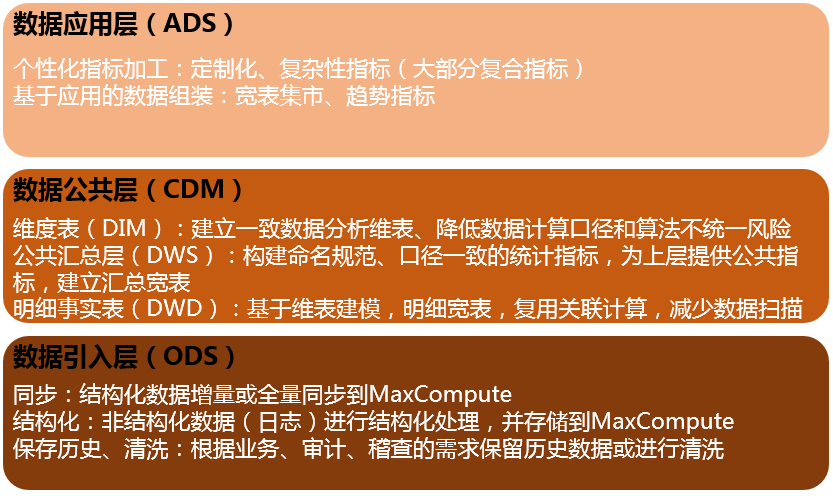dm层 集市层 四层 Build a multi-level data strategy 数据引入层(ODS,Operation Data Store)、数据公共层(CDM,Common Data Model)和数据应用层(ADS,Application Data Service)
数仓分层介绍及架构_大数据开发治理平台 DataWorks(DataWorks)-阿里云帮助中心 https://help.aliyun.com/zh/dataworks/use-cases/data-layer
在阿里巴巴的数据体系中,我们建议将数据仓库分为三层,自下而上为:数据引入层(ODS,Operation Data Store)、数据公共层(CDM,Common Data Model)和数据应用层(ADS,Application Data Service)。
数据仓库的分层和各层级用途如下图所示。
-
数据引入层ODS(Operation Data Store):存放未经过处理的原始数据至数据仓库系统,结构上与源系统保持一致,是数据仓库的数据准备区。主要完成基础数据引入到MaxCompute的职责,同时记录基础数据的历史变化。
-
数据公共层CDM(Common Data Model,又称通用数据模型层),包括DIM维度表、DWD和DWS,由ODS层数据加工而成。主要完成数据加工与整合,建立一致性的维度,构建可复用的面向分析和统计的明细事实表,以及汇总公共粒度的指标。
-
公共维度层(DIM):基于维度建模理念思想,建立整个企业的一致性维度。降低数据计算口径和算法不统一风险。
公共维度层的表通常也被称为逻辑维度表,维度和维度逻辑表通常一一对应。
-
公共汇总粒度事实层(DWS):以分析的主题对象作为建模驱动,基于上层的应用和产品的指标需求,构建公共粒度的汇总指标事实表,以宽表化手段物理化模型。构建命名规范、口径一致的统计指标,为上层提供公共指标,建立汇总宽表。
公共汇总粒度事实层的表通常也被称为汇总逻辑表,用于存放派生指标数据。
-
明细粒度事实层(DWD):以业务过程作为建模驱动,基于每个具体的业务过程特点,构建最细粒度的明细层事实表。可以结合企业的数据使用特点,将明细事实表的某些重要维度属性字段做适当冗余,即宽表化处理。
明细粒度事实层的表通常也被称为逻辑事实表。
-
-
数据应用层ADS(Application Data Service):存放数据产品个性化的统计指标数据。根据CDM与ODS层加工生成。
该数据分类架构在ODS层分为三部分:数据准备区、离线数据和准实时数据区。整体数据分类架构如下图所示。 在本教程中,从交易数据系统的数据经过DataWorks数据集成,同步到数据仓库的ODS层。经过数据开发形成事实宽表后,再以商品、地域等为维度进行公共汇总。
在本教程中,从交易数据系统的数据经过DataWorks数据集成,同步到数据仓库的ODS层。经过数据开发形成事实宽表后,再以商品、地域等为维度进行公共汇总。
整体的数据流向如下图所示。其中,ODS层到DIM层的ETL(萃取(Extract)、转置(Transform)及加载(Load))处理是在MaxCompute中进行的,处理完成后会同步到所有存储系统。ODS层和DWD层会放在数据中间件中,供下游订阅使用。而DWS层和ADS层的数据通常会落地到在线存储系统中,下游通过接口调用的形式使用。
层次调用规范
ADS应用层优先调用数据仓库公共层数据。如果已经存在CDM层数据,不允许ADS应用层跨过CDM中间层从ODS层重复加工数据。CDM中间层应该积极了解应用层数据的建设需求,将公用的数据沉淀到公共层,为其他数据层次提供数据服务。同时,ADS应用层也需积极配合CDM中间层进行持续的数据公共建设的改造。避免出现过度的ODS层引用、不合理的数据复制和子集合冗余。总体遵循的层次调用原则如下:
-
ODS层数据不能直接被应用层任务引用。如果中间层没有沉淀的ODS层数据,则通过CDM层的视图访问。CDM层视图必须使用调度程序进行封装,保持视图的可维护性与可管理性。
-
CDM层任务的深度不宜过大(建议不超过10层)。
-
一个计算刷新任务只允许输出一个表,特殊情况除外。
-
如果多个任务刷新输出一个表(不同任务插入不同的分区),DataWorks上需要建立一个虚拟任务,依赖多个任务的刷新和输出。通常,下游应该依赖此虚拟任务。
-
CDM汇总层优先调用CDM明细层,可累加指标计算。CDM汇总层尽量优先调用已经产出的粗粒度汇总层,避免大量汇总层数据直接从海量的明细数据层中计算得出。
-
CDM明细层累计快照事实表优先调用CDM事务型事实表,保持数据的一致性。
-
有针对性地建设CDM公共汇总层,避免应用层过度引用和依赖CDM层明细数据。
集市层
四层模型
ODS(临时存储层)
MID(中间层)
DM(数据集市层)
APP(应用层)
http://www.datamartist.com/data-warehouse-vs-data-mart

【全集 子集】
Data Warehouse:
- Holds multiple subject areas
- Holds very detailed information
- Works to integrate all data sources
- Does not necessarily use a dimensional model but feeds dimensional models.
Data Mart
- Often holds only one subject area- for example, Finance, or Sales
- May hold more summarised data (although many hold full detail)
- Concentrates on integrating information from a given subject area or set of source systems
- Is built focused on a dimensional model using a star schema.

【多层数据策略】
Build a multi-level data strategy
- Level 1- Get the data to the people
- Level 2- Build Departmental Data Marts
- Level 3- Plan long term infrastructure and architecture
Don't do these things in order- this isn't step 1, 2, 3- actively work on all three levels at once and ensure the plans at each level are coordinated.
Operational data store
An ODS is not an intrinsic part of an Enterprise Data Hub solution, although an EDH may be used to subsume some of the processing performed by an ODS and the Enterprise Data Warehouse. An EDH is a broker of data. An ODS is certainly not.
An operational data store (or "ODS") is a database designed to integrate data from multiple sources for additional operations on the data, for reporting, controls and operational decision support. Unlike a production master data store, the data is not passed back to operational systems. It may be passed for further operations and to the data warehouse for reporting.
Because the data originate from multiple sources, the integration often involves cleaning, resolving redundancy and checking against business rules for integrity. An ODS is usually designed to contain low-level or atomic (indivisible) data (such as transactions and prices) with limited history that is captured "real time" or "near real time" as opposed to the much greater volumes of data stored in the data warehouse generally on a less-frequent basis.
The general purpose of an ODS is to integrate data from disparate source systems in a single structure, using data integration technologies like data virtualization, data federation, or extract, transform, and load (ETL). This will allow operational access to the data for operational reporting, master data or reference data management.
An ODS is not a replacement or substitute for a data warehouse or for a data hub but in turn could become a source.



